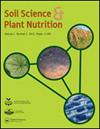Detection of metabolites in rhizosphere of soybean under different status of soil potassium
IF 1.8
4区 农林科学
Q3 ENVIRONMENTAL SCIENCES
引用次数: 0
Abstract
ABSTRACT Nutrient status of plant affects root exudates of plant. Little is known about effect of potassium status on root exudation. Objective of this study was to identify metabolites in rhizosphere soil of soybean under different potassium conditions. Two soybean cultivars (Satonohohoemi (SAT) and Tachinagaha (TAC)) were grown in soil culture under low (K0, without potassium fertilizer) and normal (K2, 0.42 g K kg−1) soil potassium status. Soil solutions were collected at 15 and 25 DAS. Metabolites in soil solution were detected by CE-TOF MS. Low potassium tolerance was higher in SAT than TAC. Shoot and root K concentration in SAT was lower in K0 than that in K2. Forty-seven metabolites were detected in rhizosphere soil solution of SAT, TAC and without plant. Low K condition increased 6 and 3 metabolites concentration in soil solution without plant and 2 and 4 metabolites concentration with SAT and 2 and 1 metabolites concentration with TAC, at 15 and 25 DAS, respectively. Low K condition decreased 1 and 1 metabolites concentration in soil solution without plant and 6 and 6 metabolites concentration with SAT and 0 and 2 metabolites concentration with TAC, at 15 and 25 DAS, respectively. Increased and decreased metabolites were different between SAT and TAC. These results suggest that K status affect metabolites in root exudate and rhizosphere microbes of soybean and there is cultivar difference in these metabolites.不同土壤钾状态下大豆根际代谢物的检测
植物的营养状况影响植物根系分泌物。钾对根系分泌物的影响尚不清楚。本研究的目的是鉴定不同钾胁迫条件下大豆根际土壤代谢产物。2个大豆品种Satonohohoemi (SAT)和Tachinagaha (TAC)分别在低(K0,无钾肥)和正常(K2, 0.42 g K kg−1)土壤钾状态下进行栽培。在15和25 DAS收集土壤溶液。采用CE-TOF ms检测土壤溶液中代谢物。在K0条件下,SAT的茎部和根部钾浓度低于K2条件下。在无植株的根际土壤溶液中检测到47种代谢物。低钾条件下,无植物土壤溶液中6、3种代谢物浓度、SAT中2、4种代谢物浓度和TAC中2、1种代谢物浓度分别在15和25 DAS时升高。低钾条件下,无植物土壤溶液中1、1种代谢物浓度、6、6种代谢物浓度、6、6种代谢物浓度和0、2种代谢物浓度分别在DAS 15和25时降低。代谢产物的增加和减少在SAT和TAC之间是不同的。这些结果表明,钾离子状态影响大豆根分泌物和根际微生物代谢产物,且这些代谢产物在不同品种间存在差异。
本文章由计算机程序翻译,如有差异,请以英文原文为准。
求助全文
约1分钟内获得全文
求助全文
来源期刊

Soil Science and Plant Nutrition
农林科学-农艺学
CiteScore
4.80
自引率
15.00%
发文量
56
审稿时长
18-36 weeks
期刊介绍:
Soil Science and Plant Nutrition is the official English journal of the Japanese Society of Soil Science and Plant Nutrition (JSSSPN), and publishes original research and reviews in soil physics, chemistry and mineralogy; soil biology; plant nutrition; soil genesis, classification and survey; soil fertility; fertilizers and soil amendments; environment; socio cultural soil science. The Journal publishes full length papers, short papers, and reviews.
 求助内容:
求助内容: 应助结果提醒方式:
应助结果提醒方式:


